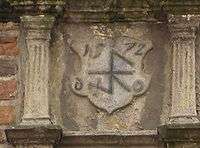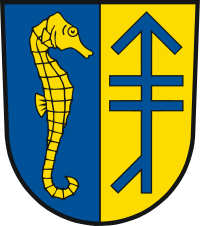House mark




House mark is originally a mark of property, later also used as a family or clan emblem, incised on the facade of a building, on animals, in signet and similar in the farmer and burgher culture of Germany and Scandinavia.
The tradition originates with the mason's marks used in the Middle Ages.
These marks have the appearance of glyphs or runes consisting of a pattern of simple lines, without the application of colour.
Background
The purpose of a house mark is to have a recognisable mark that a person, a nuclear family, multiple generations of an extended family or an owner of a property can use to mark objects, cattle or buildings for recognition of ownership. The use of house marks dates back to long before writing was public knowledge.
Besides farmers, house marks have also been used by merchants, tradesman, artisans and other town burghers on for example Bryggen in Bergen, on building blocks in the Nidaros Cathedral, and on personal seals in other Norwegian cities. There are also house marks written by hand on documents, for instance house marks of mining workers at Røros.
The Norwegian word bomerke or boemerke probably came from Denmark. There is no Norwegian reference before the 17th century. Today bomerke is mainly written as bumerke in Norwegian. Both in Denmark and Sweden, the word bomerke (with multiple spellings) is used since the 14th century and in the 16th century. In the Icelandic codes of law from the Middle Ages, one finds the word einkunn used to denote owner marks used to tag animals. It is likely that this word has also been used in Norway.[1]
In Finnish, the word puumerkki ("insignia") means a distinguishing mark or sign used by illiterate persons as a replacement of a written signature in official documents.
Description
House marks differ from the more complicated patterns of coat of arms and flags, which include surfaces and solid colors.
The form of house marks is based on function. They should be easy to cut, scratch or engrave with a knife or similar tool. At the same time they should be distinctive and easy to remember.
House marks can be made from one or two lines and up to quite a complex pattern of line figures. Based on appearance house marks resemble line figures in rock carvings and in early writing systems. It is unclear how extensive such ancient line figures were used as marks for people or property ownership.
The basic forms of a house mark is often runes, characters and numbers, stylized figures, international symbols like crosses, stars, and astrological or astronomical characters.
One characteristic of house marks is that they may consist of a basic form with addition or deduction of lines. In this way related people can have marks that resemble each other, but differ by details. This is equivalent to cadency and adding brisures as methods to change the coat of arms.
Many house marks are placed in the shield-shaped frames. We see this in seals, on buildings and on tombstones, for both farmers and city dwellers in Scandinavia and German areas, during the 1700 and 1800 century. Some of these house mark shields also has color and is approaching the heraldic coat of arms.
See also
Notes
References
- Norwegian
- Sivert Aarflot: Om nogle af Hovedkaraktererne iblandt de saakaldte gamlævis Bumærkji, som ellers heder Runebogstaver, Norsk Landboeblad 1811
- H. J. Huitfeldt-Kaas, Oluf Kolsrud et al.: Norske Sigiller fra Middelalderen, Kristiania - Oslo 1899-1950
- Fredrik B. Wallem: En indledning til studiet af de nordiske bomærker, Årbok 1902 for Foreningen til Norske Fortidsminners Bevaring, Kristiania 1903
- Johan Koren Wiberg: Bomerker og Innflyttere vedkommende Kontoret i Bergen, Det Hanseatiske Museums Skrifter Nr 10, Bergen 1935
- Rikard Berge: «Bumerke», Vinje og Rauland, Stavanger 1940, pages 348-354
- L. Strømme: Bumerke frå Sunnmøre, Oslo 1943
- K. and Jon Haukanes: Segl og bumerke frå Hardanger, Oslo 1944
- Hans Krag: Norsk heraldisk mønstring fra Fredrik IV’s regjeringstid 1699-1730, bind II, Ålo 1955
- Hans Krag: Tømmermerker og bomerker, Heraldisk Tidsskrift 1/53, København 1960
- Hans Krag: Nogen norske seglmerker, Heraldisk Tidsskrift 1/157, København 1961
- Lars Kindem: Vossaboki 2, Voss 1933-38 (nytt opplag 1981)
- Jakob H. Vik: Bumerke frå Kvam i Hordaland, Hardanger Historielags tilleggskrift nr 13, Øystese 1962
- Kristian A. Bentsen: Merker og bumerker, Agder historielags årsskrift nr 46, Kristiansand S 1968
- Albert Joleik: Soga om Flora, Flora 1980, med bumerker tilrettelagt av Anders J. Moen
- Åsta Østmoe Kostveit: Kors i kake, skurd i tre. Tegn og symboler i folkekulturen, Oslo 1997
- Hans Cappelen: Bumerker i Norge (Oslo 2005)
- Hans Cappelen: «Bumerker i Norge - en oversikt», in Anders Bjønnes et al.: Segltegninger fra hyllingene i Norge 1591 og 1610, Oslo 2010
- Danish
- Allan Tønnesen: Helsingørs bomærker, København 1968
- Allan Tønnesen: Bomerker og runer, Heraldisk Tidsskrift 51/23, København 1985
- Allan Tønnesen (editor): Magtens besegling. Enevoldsarveregeringsakterne af 1661 og 1662 underskrevet og beseglet af stænderne i Danmark, Norge, Island og Færøerne, Syddansk Universitetsforlag, Odense 2013, 583 p., ISBN 9788776746612.
- Swedish
- Tuve Skånberg: Glömda gudstecken. Från fornkyrklig dopliturgi till allmogens bomärken (2003) under Creative Commons BY-NC-ND 2.5 licens
- German
- C. G. Homeyer: Die Haus- und Hofmarken, Berlin 1870
- H. Spruth: Die Hausmarke, Wesen und Bibliographie, Neustadt a.d.A. 1960
External links
- Norwegian
- Bumerker (with multiple examples)
- Bumerker i Norge

